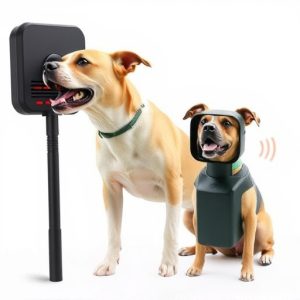Dog Repellent Devices: Navigate Low Battery & Effective Bark Prevention
Dog repellent electronic devices effectively curb excessive barking through ultrasonic sounds or vib…….
Dog repellent electronic devices effectively curb excessive barking through ultrasonic sounds or vibrations. Regular maintenance, including battery monitoring via LED indicators, is essential for optimal performance. Recognizing low battery signs like reduced sound intensity ensures prompt recharging to avoid false triggers distressing pets. Beyond technology, a holistic approach includes understanding dog behavior, providing exercise and routine, establishing boundaries, and addressing health issues through veterinary care for effective bark prevention.
“Discover the revolutionary power of electronic bark prevention devices, designed to gently yet effectively curb excessive canine barking. This article explores how these innovative tools operate, shedding light on their inner workings and safety features. We’ll guide you through recognizing critical low battery warning signs, ensuring uninterrupted protection for your peaceful haven. Moreover, we delve into comprehensive bark prevention strategies that complement these devices, providing a multi-faceted approach to training and behavior modification.”
- Understanding Dog Repellent Electronic Devices: How They Work
- Low Battery Warning Signs: Staying Ahead of Your Dog Repeller
- Effective Bark Prevention Strategies: Beyond the Device
Understanding Dog Repellent Electronic Devices: How They Work
Dog repellent electronic devices, also known as bark prevention tools, utilize various techniques to deter dogs from barking excessively. These devices emit sounds or vibrations that are unpleasant to dogs but generally harmless. They typically operate on a combination of sensors and control units. When a dog’s barking triggers the sensor, the device activates, emitting either an ultrasonic sound or a vibration, depending on the model. Ultrasonic sounds are inaudible to humans but irritant to dogs, while vibrations can be felt, causing discomfort and encouraging the dog to stop barking.
Regular maintenance is crucial for these devices, including keeping an eye out for low battery warning signs. Some indicators include reduced sound intensity or intermittent activation. Most models feature LED indicators that signal battery life, allowing users to replace or recharge them promptly to avoid disruption in training. Ensuring optimal battery performance is essential not only for the device’s effectiveness but also to prevent any distress to your pet caused by false triggers due to a dead battery.
Low Battery Warning Signs: Staying Ahead of Your Dog Repeller
When using a bark prevention electronic handheld device, recognizing low battery warning signs is crucial to ensure its effectiveness as a dog repellent. One of the first indicators is reduced performance; if the device seems less responsive or takes longer to react when triggered, it might be due to a drained battery. Additionally, unusual behavior like random activation or ineffectiveness could point towards a low power level.
Staying ahead of these signs is essential for maintaining optimal bark control. Regularly check the device’s power levels, especially after prolonged use or exposure to colder temperatures, which can drain the battery faster. Carrying a spare battery or using a portable charger can be beneficial during outdoor walks or in remote areas, ensuring you have a reliable dog repellent at all times.
Effective Bark Prevention Strategies: Beyond the Device
Effective Bark Prevention strategies extend far beyond the mere possession of an electronic handheld device. While technology offers innovative solutions, such as advanced bark detectors and remote trainers, a comprehensive approach to deterring unwanted barking involves addressing the root causes. Understanding your dog’s behavior is key; identifying triggers like anxiety, boredom, or territorial instincts allows for tailored interventions. For instance, providing mental stimulation through interactive toys or regular training sessions can significantly reduce excessive barking.
Additionally, establishing clear boundaries and consistency in training is vital. Regular walks, adequate exercise, and a well-structured routine contribute to a dog’s overall contentment, minimizing the likelihood of bark-inducing stress or boredom. Moreover, addressing any underlying health issues, such as pain or discomfort, can make a world of difference. Veterinarians play a crucial role in identifying and treating medical conditions that might lead to excessive barking, providing owners with an additional layer of control over their pet’s behavior.
While electronic bark prevention devices can be effective tools for managing excessive dog barking, it’s crucial to stay vigilant regarding low battery warning signs. Regularly checking the device’s power level and replacing batteries when necessary is essential to ensure continuous protection. Remember that these devices are just one aspect of a comprehensive approach to bark prevention; combining them with positive reinforcement training and environmental adjustments can lead to even better results. By staying proactive and utilizing both technological and behavioral strategies, you can help create a calmer and more harmonious environment for both you and your canine companion.


